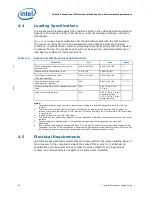
Thermal Solutions
38
Thermal/Mechanical Design Guide
5.6.1.1
T
CONTROL
Guidance
Factory configured T
CONTROL
values are available in the appropriate Dear Customer
Letter or may be extracted by issuing a Mailbox or an RDMSR instruction. See the
appropriate datasheet for more information.
Due to increased thermal headroom based on thermal characterization on the latest
processors, customers have the option to reduce T
CONTROL
to values lower than the
factory configured values.
In some situations, use of reduced T
CONTROL
Guidance can reduce average fan power
and improve acoustics. There are no plans to change Intel's specification or the factory
configured T
CONTROL
values on individual processors.
To implement this guidance, customers must re-write code to set T
CONTROL
to the
reduced values provided in the table below. Implementation is optional. Alternately, the
factory configured T
CONTROL
values can still be used, or some value between factory
configured and Guidance. Regardless of T
CONTROL
values used, BIOS needs to identify
the processor type.
Notes:
1.
Use factory configured T
CONTROL
values.
Implementation of T
CONTROL
Guidance above maintains Intel standards of reliability
(based on modeling of the Intel Reference Design). Implementation of T
CONTROL
of -1
may increase risk of throttling (Thermal Control Circuit activation). Increased TCC
activation may or may not result in measurable performance loss.
Thermal Profile still applies. If PECI >= T
CONTROL
Guidance, then the case temperature
must meet the Thermal Profile.
5.6.2
PECI Averaging and Catastrophic Thermal Management
By averaging DTS over PECI, thermal solution failure can be detected and a soft
shutdown can be initiated to help prevent loss of data.
Thermal data is averaged over a rolling window of 256 mS by default (X=8):
AVG
N
= AVG
N-1
* (1 – 1/2
X
) + Temperature * 1/2
X
Table 5-5.
T
CONTROL
Guidance
TDP
T
CONTROL
Guidance
Comment
130W
See Note 1
Intel® Xeon® Processor 5500 Series
95W
-10
Intel® Xeon® Processor 5500 Series with 2.93 GHz Max Core Frequency
95W
-1
Intel® Xeon® Processor 5500 Series frequencies lower than 2.93 GHz
80W
-1
Intel® Xeon® Processor 5500 Series 2.53 GHz or lower, except Embedded (NEBS)
60W
-1
Intel® Xeon® Processor 5500 Series 2.26 GHz or lower, except Embedded (NEBS)
130W
See Note 1
Intel Xeon processor 5600 series (6 core and 4 core)
95W
-1
Intel Xeon processor 5600 series (6 core) 2.93 GHz or lower
95W
-1
Intel Xeon processor 5600 series (4 core) 3.06 GHz or lower
80W
-1
Intel Xeon processor 5600 series (4 core) 2.66 GHz or lower, except Embedded
60W
-1
Intel Xeon processor 5600 series (6 core) 2.26 GHz or lower, except Embedded
40W
-1
Intel Xeon processor 5600 series (4 core) 2.13 GHz or lower, except Embedded
Summary of Contents for X5550 - Quad Core Xeon
Page 8: ...8 Thermal Mechanical Design Guide ...
Page 12: ...Introduction 12 Thermal Mechanical Design Guide ...
Page 24: ...Independent Loading Mechanism ILM 24 Thermal Mechanical Design Guide Figure 3 3 ILM Assembly ...
Page 26: ...Independent Loading Mechanism ILM 26 Thermal Mechanical Design Guide ...
Page 48: ...Component Suppliers 48 Thermal Mechanical Design Guide ...
Page 82: ...Mechanical Drawings 82 Thermal Mechanical Design Guide ...
Page 88: ...Socket Mechanical Drawings 88 Thermal Mechanical Design Guide ...















































